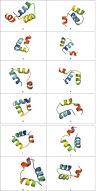Ethnobotany and Antimicrobial Peptides From Plants of the Solanaceae Family: An Update and Future Prospects
- PMID: 32477108
- PMCID: PMC7232569
- DOI: 10.3389/fphar.2020.00565
Ethnobotany and Antimicrobial Peptides From Plants of the Solanaceae Family: An Update and Future Prospects
Abstract
The Solanaceae is an important plant family that has been playing an essential role in traditional medicine and human nutrition. Members of the Solanaceae are rich in bioactive metabolites and have been used by different tribes around the world for ages. Antimicrobial peptides (AMPs) from plants have drawn great interest in recent years and raised new hope for developing new antimicrobial agents for meeting the challenges of antibiotic resistance. This review aims to summarize the reported AMPs from plants of the Solanaceae with possible molecular mechanisms of action as well as to correlate their traditional uses with reported antimicrobial actions of the peptides. A systematic literature study was conducted using different databases until August 2019 based on the inclusion and exclusion criteria. According to literature, a variety of AMPs including defensins, protease inhibitor, lectins, thionin-like peptides, vicilin-like peptides, and snaking were isolated from plants of the Solanaceae and were involved in their defense mechanism. These peptides exhibited significant antibacterial, antifungal and antiviral activity against organisms for both plant and human host. Brugmansia, Capsicum, Datura, Nicotiana, Salpichora, Solanum, Petunia, and Withania are the most commonly studied genera for AMPs. Among these genera, Capsicum and the Solanum ranked top according to the total number of studies (35%-38% studies) for different AMPs. The mechanisms of action of the reported AMPs from Solanaceae was not any new rather similar to other reported AMPs including alteration of membrane potential and permeability, membrane pore formation, and cell aggregation. Whereas, induction of cell membrane permiabilization, inhibition of germination and alteration of hyphal growth were reported as mechanisms of antifungal activity. Plants of the Solanaceae have been used traditionally as antimicrobial, insecticidal, and antiinfectious agents, and as poisons. The reported AMPs from the Solanaceae are the products of chemical shields to protect plants from microorganisms and pests which unfold an obvious link with their traditional medicinal use. In summary, it is evident that AMPs from this family possess considerable antimicrobial activity against a wide range of bacterial and fungal pathogens and can be regarded as a potential source for lead molecules to develop new antimicrobial agents.
Keywords: Solanaceae; antibiotic resistance; antimicrobial peptides; ethnobotany; traditional medicine.
Copyright © 2020 Afroz, Akter, Ahmed, Rouf, Shilpi, Tiralongo, Sarker, Göransson and Uddin.
Figures


References
-
- Allen N. K., Brilliantine L. (1969). A Survey of Hemagglutinins in Various Seeds. J. Immunol. 102, 1295–1299. - PubMed
-
- Amedei A., Niccolai. E. (2014). “Plant and Marine Sources: Biological activity of natural products and therapeutic use,” in Natural Product Analysis: Instrumentation, Metods and Applicatoins. Eds. Havlicek V., J. Spizekgf (New Jersy, USA: John Wiley and Sons, Inc.), 43.
-
- Bard V. G. C., Nascimento V. V., Oliveira A. E. A., Rodrigues R., Cunha D. M., Dias G. B., et al. (2014). Vicilin-like peptides from Capsicum baccatum L. seeds are α-amylase inhibitors and exhibit antifungal activity against important yeasts in medical mycology. Pept. Sci. 102, 335–343. 10.1002/bip.22504 - DOI - PubMed
Publication types
LinkOut - more resources
Full Text Sources

